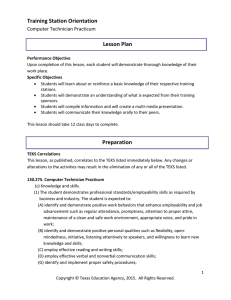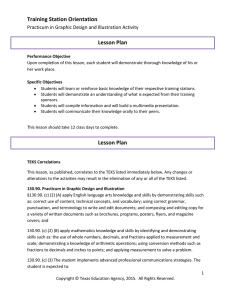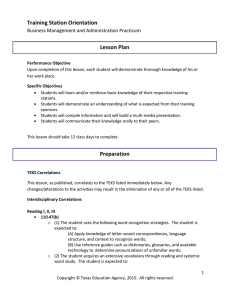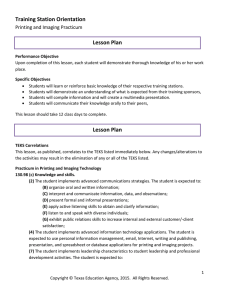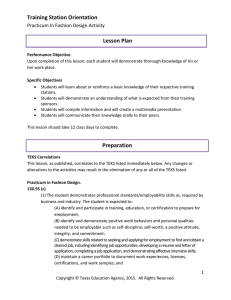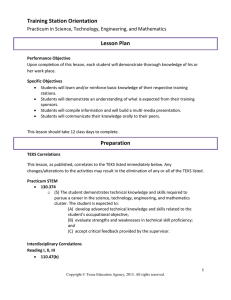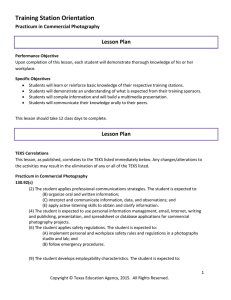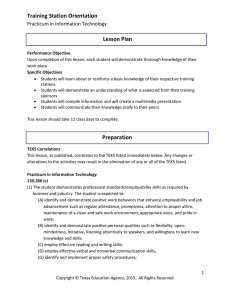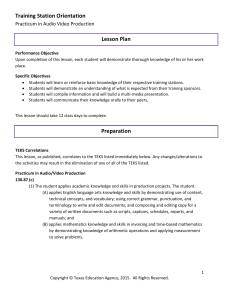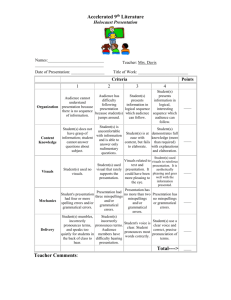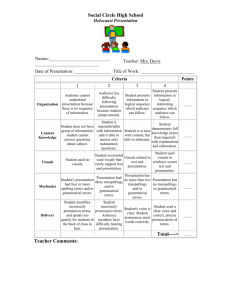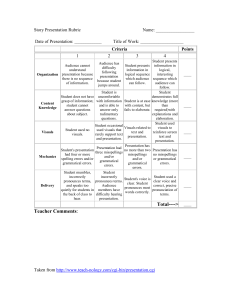Training Station Orientation Lesson Plan Practicum in Animation
advertisement
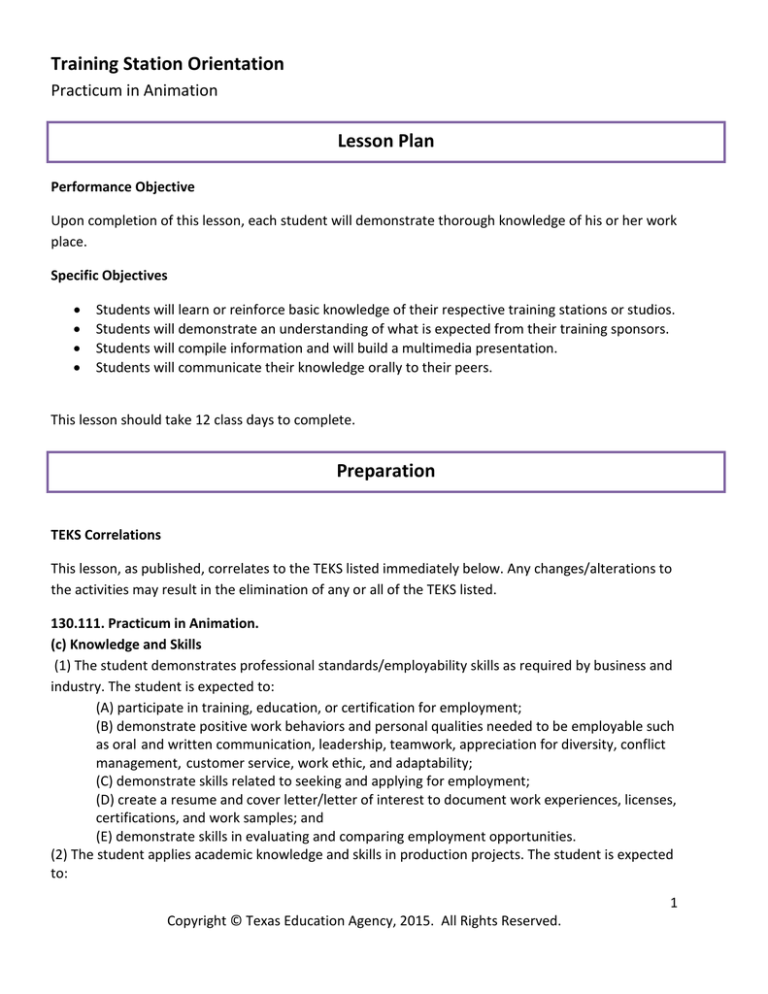
Training Station Orientation Practicum in Animation Lesson Plan Performance Objective Upon completion of this lesson, each student will demonstrate thorough knowledge of his or her work place. Specific Objectives • • • • Students will learn or reinforce basic knowledge of their respective training stations or studios. Students will demonstrate an understanding of what is expected from their training sponsors. Students will compile information and will build a multimedia presentation. Students will communicate their knowledge orally to their peers. This lesson should take 12 class days to complete. Preparation TEKS Correlations This lesson, as published, correlates to the TEKS listed immediately below. Any changes/alterations to the activities may result in the elimination of any or all of the TEKS listed. 130.111. Practicum in Animation. (c) Knowledge and Skills (1) The student demonstrates professional standards/employability skills as required by business and industry. The student is expected to: (A) participate in training, education, or certification for employment; (B) demonstrate positive work behaviors and personal qualities needed to be employable such as oral and written communication, leadership, teamwork, appreciation for diversity, conflict management, customer service, work ethic, and adaptability; (C) demonstrate skills related to seeking and applying for employment; (D) create a resume and cover letter/letter of interest to document work experiences, licenses, certifications, and work samples; and (E) demonstrate skills in evaluating and comparing employment opportunities. (2) The student applies academic knowledge and skills in production projects. The student is expected to: Copyright © Texas Education Agency, 2015. All Rights Reserved. 1 (A) apply English language arts knowledge and skills by consistently demonstrating use of content, technical concepts, and vocabulary; using correct grammar, punctuation, and terminology to write and edit documents; and composing and editing copy for a variety of written documents such as scripts, captions, schedules, reports, manuals, proposals, and other client-based documents; and (B) apply mathematics knowledge and skills in invoicing and time-based mathematics by consistently demonstrating knowledge of arithmetic operations and applying measurement to solve problems. (3) The student implements advanced professional communications strategies. The student is expected to: (A) adapt language for audience, purpose, situation, and intent such as structure and style; (B) formulate, analyze, and organize oral and written information; (C) formulate, analyze, interpret, and communicate information, data, and observations; (D) create and present formal and informal presentations; (E) apply active listening skills to obtain and clarify information; (F) listen to and speak with diverse individuals; and (G) exhibit public relations skills to increase internal and external customer/client satisfaction. (4) The student implements advanced problem-solving methods. The student is expected to: (A) employ critical-thinking skills, including data gathering and interpretation independently and in teams; and (B) employ interpersonal skills in teams to solve problems and make decisions. (5) The student implements advanced technology applications and processes. The student is expected to: (A) use technology applications such as social media, email, Internet, writing and publishing, presentation, and spreadsheet or database applications for animation projects; and (B) use processes such as personal information management, file management and file sharing. (10) The student demonstrates appropriate career-building characteristics and maintains a professional portfolio. The student is expected to: (A) maintain a career portfolio to document work experiences, licenses, certifications, and work samples; (B) demonstrate skills in evaluating and comparing employment opportunities; (C) examine and employ professional networking opportunities such as Career and Technology Student Organizations, professional social media, industry professional organizations; and (D) examine employment opportunities in entrepreneurship (11) The student employs effective planning and time management skills to enhance productivity. The student is expected to: Copyright © Texas Education Agency, 2015. All Rights Reserved. 2 (A) employ effective planning and time management skills to complete work tasks; and (B) use technology to enhance productivity. (16) The student practices business skills for freelance entrepreneurs. The student is expected to: (A) implement standard freelance entrepreneur self-promotion techniques; (B) develop proposals, standard billing and collection practices; (C) research freelance entrepreneur start-up practices; and (D) use information technology applications common to freelance entrepreneurs. (17) The student develops an understanding of professional employment strategies through practical experience in the career cluster. The student is expected to: (A) identify types and requirements of potential employers; (B) use clear and appropriate communications to convey skill set to others; and (C) understand and apply federal laws regarding lawful employment interviews. (18) The student develops an understanding of appropriate interview strategies in professional contexts. The student is expected to: (A) employ appropriate verbal, nonverbal, and listening skills; (B) use clear and appropriate communications to convey skill set to others; (C) understand and apply federal laws regarding lawful employment interviews; and (D) identify and use appropriate strategies for dealing with differences such as gender, ethnicity, and age. Interdisciplinary Correlations English 110.42(b) Knowledge and skills (6) Reading/word identification/vocabulary development. The student uses a variety of strategies to read unfamiliar words and to build vocabulary. The student is expected to: (A) expand vocabulary through wide reading, listening, and discussing; and (B) rely on context to determine meanings of words and phrases such as figurative language, idioms, multiple meaning words, and technical vocabulary. (7) Reading/comprehension. The student comprehends selections using a variety of strategies. The student is expected to: (F) identify main ideas and their supporting details; (G) summarize texts; and (J) read silently with comprehension for a sustained period of time. Copyright © Texas Education Agency, 2015. All Rights Reserved. 3 Speech 110.56 (b) Knowledge and skills (1)(A) Explain the importance of communication in daily interaction. (2)(E) Participate appropriately in conversations for a variety of purposes. (3)(A) Use appropriate communication in group settings. (E) Use appropriate verbal, non-verbal, and listening strategies to communicate effectively in groups. (5)(B) Use language clearly and appropriately. (E) Interact with audiences appropriately. Tasks • Students will interview employer or owner to obtain necessary information • Students will obtain company information from employee handouts, trade journals, or employee handbooks Accommodations for Learning Differences It is important that lessons accommodate the needs of every learner. These lessons may be modified to accommodate your students with learning differences by referring to the files found on the Special Populations page of this website (cte.unt.edu). Preparation • Secure the computer lab if you do not have immediate access to one in your classroom. • Copy the handout sheets and rubric for the students. Instructional Aids • Student handouts • Grading rubric • Internet access Materials Needed • Paper for essay • Camera or phone with camera • Flash drive Equipment Needed • Computers (for students to complete project) • Projector (for digital presentation) • Scanner to scan pictures or materials brought to class Copyright © Texas Education Agency, 2015. All Rights Reserved. 4 Outline MI OUTLINE Assignment Outline: I. Directions: a. The packet of information must be completed by interview, website, or handbook. b. Minimum of 12 digital photos c. Floor plan may be scanned II. Grading: a. Completion of packet b. Multimedia presentation c. Pictures d. Professionalism during presentation III. Presentation must have: a. Name and logo b. Floor plan c. Policies/procedures d. Company history e. Supervisor’s or owner’s previous experience f. Site of company g. Organizational chart h. Inclusion: i. 3,2,1 IV. Layout format must be followed ***Handout the Portfolio Guidelines (p. 193) NOTES TO TEACHER Copy the instructions and grading rubric and make into a packet. Tell the class about some of the things you learned at previous jobs. Explain how those skills helped you to become a teacher. Explain the necessity of learning as much as possible about a job because some of the skills learned will help with future employment. Explain to the class that customers see a business much differently than the employees see it. Ask the class if they ever wanted to work at a place that produced a game or movie they admired. Have them give reasons why they wanted to work there. Go over all the criteria in the assignment and check for understanding. Explain the guidelines. Students can set it up while working on the Training Station Orientation project. Copyright © Texas Education Agency, 2015. All Rights Reserved. 5 Multiple Intelligences Guide Existentialist Interpersonal Intrapersonal Kinesthetic/Bodily Logical/Mathematical Musical/Rhythmic Naturalist Verbal/Linguistic Visual/Spatial Application Guided Practice Using the digital presentation, the teacher will go over the requirements of this project. The student will follow along and make notes on their hard copy. Students will be strongly encouraged to take the assignment packet to their job sites so employers will know about the activity. Ask students to “map” out their plan, using a Mapping Tool from the Appendix of this document. Give some ideas to students during the brainstorming session before the end of the first class period. Independent Practice • Students will work at their own pace to complete this activity. • All work is to be done in class, with the exception of the interviews, so the teacher can check for understanding. • Students are strongly encouraged to take ownership of this activity and use time management skills to complete the assignment on time. • Students should strive to produce the highest quality product. • Students should be prepared to present their projects to the class. Copyright © Texas Education Agency, 2015. All Rights Reserved. 6 Employer Project Directions: You are to complete this packet of information by conducting interviews with employers or managers. If you have an employee training manual, you may use it as a source. You might even have to get some information from your company’s website. In addition to the packet, you will include a minimum of 12 digital photos in your presentation. You may bring the pictures to class on a flash drive, a memory card or upload them to a cloud storage site. All information will be compiled to prepare an animated presentation that will be shown to the class when you present your project. You will be graded on: Completion of the packet Animated presentation Use of pictures (as specified) Professionalism during presentation, including professional dress **Bonus credit will be given if your employer attends your presentation! Presentation must have: Name and logo of company Floor Plan Policies and Procedures History of the company Supervisor’s (or owner’s) previous experience Site of company (including number of employees) Organizational chart Miscellaneous supplemental information Titles and transitions must be animated Photos (either dispersed within the presentation or at the end of the presentation) If you were in charge, explain: 3 things you like about the training station 2 things you would change 1 thing you have learned that will help you in your career choice This project is due on: ___________________________ Copyright © Texas Education Agency, 2015. All Rights Reserved. 7 Layout Format: 1. 2. 3. 4. Student’s name Company’s name, address Type of company In a minimum of 75 words, typed and turned in separately, state what your first day on the job was like. 5. Procedures for reporting to work 6. Procedures for calling in sick or calling in late 7. Procedures for asking for time off 8. What types of benefits are available 9. Length of time manager or owner has been with company 10. What prior training did the manager or owner have? 11. What type of education is needed for a managerial position with the company? 12. Procedure for handling cash or legal documents (beginning and ending shifts), OR 13. Procedure for accessing or handling clients’ files 14. Names of competitors and their locations 15. Organizational chart 16. Floor plan 17. Names of vendors and suppliers 18. Procedures for handling returns, issuing credit, keeping clientele happy 19. What types of jobs/careers will your current training station prepare you for? 20. What is the procedure for handling theft (by employees or clientele)? 21. What is the strangest thing that has happened to you on the job? Copyright © Texas Education Agency, 2015. All Rights Reserved. 8 Summary Review • Why do customers see a different perspective of a business operation that that of the employees? • Why is it important to learn as much as possible about the business establishment? • Why are procedures established and expected to be followed? Evaluation Informal Assessment • Instructor will observe students during Guided and Independent Practice. • Instructor will assist students as needed. Formal Assessment • Use the Individual Presentation Rubric to evaluate presentations. Copyright © Texas Education Agency, 2015. All Rights Reserved. 9 Individual Presentation Rubric Presentation Title: ___________________________________________________________ Name:___________________________ Teacher:___________________________ ID#:_____________________________ Date of Presentation:_________________ Criteria 0-5 6-10 11-15 16-20 Organization Audience cannot understand presentation because there is no sequence of information. Audience has difficulty following presentation because student jumps around. Student presents information in logical sequence that audience can follow. Student presents information in logical, interesting sequence that audience can follow. Content Knowledge Student does not have grasp of information; student cannot answer questions about subject. Student is uncomfortable with information and is only able to answer rudimentary questions. Student is at ease with content, but fails to elaborate. Student demonstrates full knowledge (more than required) with explanations and elaboration. Visuals Student used no visuals. Student occasionally used visuals that rarely support text and presentation. Visuals related to text and presentation. Student used visuals to reinforce screen text and presentation. Mechanics Student’s presentation had four or more spelling errors and/or grammatical errors. Presentation had three misspellings and/or grammatical errors. Presentation had no more than two misspellings and/or grammatical errors. Presentation had no misspellings or grammatical errors. Delivery Student mumbles, incorrectly pronounces terms and speaks too quietly for students in the back of the class to hear. Student incorrectly pronounces terms. Audience members have difficultly hearing presentation. Student’s voice is clear. Student pronounces most words correctly. Student used clear voice and correct, precise pronunciation of terms. Total Teacher Comments: Copyright © Texas Education Agency, 2015. All Rights Reserved. 10
